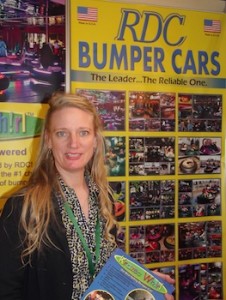Twenty-four square feet, or 7.5 square metres, is all that’s actually needed to run a successful operation using inflatable bumper cars, says the specialist in the market, RDC’s general manager, Tami Dean.


Dean’s company is based at Independence, Oregon, US, and we caught up with her at the DEAL trade show in Dubai in mid-April, when she brought a display into the Middle East exhibition for the first time since 1999.
“We came to the show in that year, but then started concentrating on European shows. We found that the Middle East operators were going to IAAPA and we could see them there. But the growing importance of DEAL has led to many of them staying ‘local,’ so we decided to come to Dubai again.”
A far different DEAL greeted Dean 16 years on, but the industry has developed considerably in that time – and so has RDC. The 30-year-old company is now the only dry bumper cars producer, to differentiate it from bumper boats which look very similar, but which are operated on water attractions.
So what makes the inflated bumper cars different from the regular bumper cars? “You can operate them indoors, outdoors, gasoline-powered or battery-powered; they can be permanent or portable. I know that the regular bumper car can as well, but the main difference is in the ride. Bumper cars are notorious for becoming jammed in one part of the track with everyone trying to extricate themselves to the point where an attendant has to run over and pull them apart.
“That doesn’t happen with what is effectively a tyre-surround to the car, because they can spin on their own axle in any direction and are therefore tangle-free.”
RDC is the original manufacturer of this type of attraction and its longevity has given it a reputation for reliability. The company recognises the differences between a theme park installation and that in an FEC – it is all a question of scale, says Dean. “Naturally there is usually more space in a theme park, but FECs are growing in size and can often take full-size tracks. But if the space is limited then 7.5m is all that is required to house six cars. In the US we regularly ship installations to FEC chains and we have one customer with no fewer than 32 locations with our cars in them; all with between six and eight cars a time, although we have often installed circuits for 12 cars.”
It is normal to have an attendant for security reasons, she said, but even so the average return on investment is

